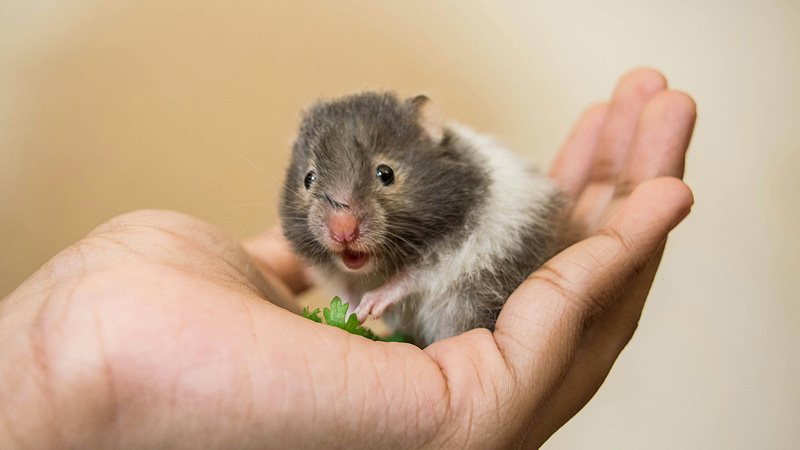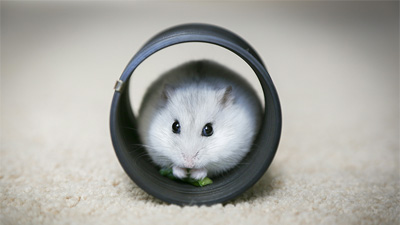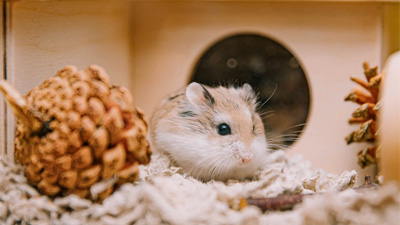Which Type of Hamster is the Friendliest?

Photo by Finney on Unsplash
Hamsters are adored by pet enthusiasts worldwide for their charming personalities, adorable appearance, and relatively low-maintenance care requirements. Among the various species of hamsters kept as pets, there is often curiosity about which type is the friendliest and most suitable for companionship. While individual temperament can vary within each species, certain factors contribute to the perceived friendliness of different hamster breeds.
In this article, we'll delve into the distinct characteristics of several popular hamster species, exploring their behaviors, tendencies, and suitability as friendly pets.
Hamster Temperaments
Before we delve into the friendliness of different hamster species, it's important to understand that each hamster has its own unique personality. Like humans, hamsters have individual behaviors and temperaments, which can be influenced by factors such as genetics, early socialization, and previous experiences.
While certain hamster species may have general temperamental traits, it's essential to keep in mind that there can be variations within each species. Some hamsters of the same species may be more outgoing and social, while others may be more timid and reserved.
In general, hamsters are solitary animals. While some individuals may enjoy human interaction and socializing, others might prefer more independent and solitary activities. It's important to respect the preferences and boundaries of your hamster, regardless of their species, and cater to their specific needs and comfort levels.
1. Syrian Hamsters: Known for their Friendliness
Among the various hamster species, Syrian hamsters (Mesocricetus auratus) are often considered the friendliest. Syrian hamsters, also known as golden hamsters, are native to the arid regions of Syria. They are the most common and widely kept hamster species as pets.
Syrian hamsters are larger compared to other hamster species, typically ranging from 5 to 7 inches in length. Their size allows for more interaction and handling compared to smaller dwarf hamsters. This larger size also makes them easier to tame and handle, leading to their reputation for friendliness.
These hamsters are known for their sociable nature and enjoy human interaction if properly socialized from a young age. Syrian hamsters can be quite affectionate, and with time and patience, they can form strong bonds with their owners. They are often more comfortable being held and handled compared to other hamster species.
However, it's important to keep in mind that individual personalities can vary within the Syrian hamster species. Some Syrian hamsters may be more outgoing and friendly, while others may be more reserved. It's important to spend time with your hamster, provide positive interactions, and give them the opportunity to get to know you at their own pace.
Dwarf Hamsters: Varied Personalities
Dwarf hamsters are a group of small hamster species that include the Roborovski, Winter White, Campbell's, and Chinese hamsters. While they may be smaller in size compared to Syrian hamsters, dwarf hamsters can still make enjoyable and friendly pets with proper socialization and care.
2. Roborovski Hamsters: Quick and Inquisitive
Roborovski hamsters (Phodopus roborovskii) are the smallest and quickest of the dwarf hamsters. They are native to the deserts of Central Asia. While they may not be as cuddly or prone to being held as Syrian hamsters, Roborovski hamsters are known for their inquisitive nature and their willingness to explore and interact with their surroundings.
These hamsters are highly active, constantly on the move, and most active during the day. Roborovski hamsters can be friendly toward their owners if they are given plenty of opportunities to bond and socialize. Providing a stimulating environment with toys and tunnels can help encourage their playful and interactive behavior.
It's important to note that Roborovski hamsters are fast and agile, making handling more challenging compared to other hamster species. They may not enjoy being held for extended periods. Instead, they prefer to be observed and interacted with during their active playtime.
3. Winter White Hamsters: Playful and Sociable
Winter White Russian hamsters (Phodopus sungorus), also known as Djungarian hamsters, are small and sociable dwarf hamsters native to Russia and Kazakhstan. They have a thick coat of fur that changes color with the seasons, turning white in winter and gray-brown in summer.
Winter Whites are known for their playful and curious nature. They are generally sociable and can enjoy human interaction if they are provided with positive experiences from a young age. These hamsters thrive in same-sex pairs or small groups and can exhibit friendly and interactive behaviors toward their owners.
While Winter White hamsters can be more social compared to other dwarf hamsters, it's essential to remember that they are still individuals with unique personalities. Some individuals may be more outgoing and affectionate, while others may be more reserved and require more time to feel comfortable with interactions.
4. Campbell's Hamsters: Active and Sociable
Campbell's Russian hamsters (Phodopus campbelli), or Campbell's hamsters, are another species of dwarf hamsters originating from the steppes of Central Asia. They have a shorter coat of fur compared to Winter White Russian hamsters and come in various colors, such as gray, brown, and black.
Campbell's hamsters are known for their active and sociable nature. They can be friendly and enjoy human interaction when provided with ample opportunities for bonding. These hamsters are active throughout the day and night, requiring mental stimulation and exercise to prevent boredom.
Just like other hamster species, individual personalities can vary among Campbell's hamsters. While some individuals may immediately warm up to human interaction, others may require more time and patience to develop a friendly and interactive bond.
5. Chinese Hamsters: Independent but Curious
Chinese hamsters (Cricetulus griseus) are slightly larger than dwarf hamsters but smaller than Syrian hamsters. They have a long and slender body with a prehensile tail that they use for balance. Chinese hamsters have a gray-brown fur coloration.
Chinese hamsters are known for their curiosity and intelligence. They are generally more independent compared to other hamster species, but they can still form bonds with their owners through proper socialization and positive interactions. These hamsters enjoy exploring their environment, making them interesting and fun to observe.
While Chinese hamsters may be less likely to seek out human interaction, they can still become accustomed to handling and develop a friendly relationship with their owners. They require a well-balanced and stimulating environment to keep them entertained and prevent them from becoming bored or stressed.
Tips for a Friendly Hamster
Regardless of the specific hamster species you choose, there are several tips you can follow to promote friendly behaviors and interactions with your pet:
Socialize from a Young Age
Proper socialization is crucial for creating a friendly and interactive hamster. Start handling and interacting with your hamster from a young age, allowing them to become familiar with your scent and presence. Gentle and consistent handling will help your hamster become comfortable with human interaction.
Use Positive Reinforcement
Use positive reinforcement techniques, such as offering treats and rewards, to encourage friendly behaviors from your hamster. Reward your hamster for approaching you, climbing onto your hand, or displaying any other desired friendly behaviors. This will help associate you with positive experiences and create a bond of trust.
Provide a Stimulating Environment
Hamsters are curious, intelligent creatures that thrive in a stimulating environment. Provide plenty of toys, tunnels, and hiding spots to keep your hamster entertained and engaged. A bored hamster may become less friendly or may exhibit negative behaviors such as biting or chewing on cage bars.
Respect Boundaries
Respecting your hamster's boundaries is essential in building a friendly relationship. Each hamster has its own comfort level and may not enjoy excessive handling or interaction. Monitor your hamster's behavior and body language to determine when they are feeling stressed or uncomfortable, and give them space when needed.
Be Patient and Understanding
Building a friendly bond with your hamster takes time, patience, and understanding. Avoid rushing the process and allow your hamster to gradually become more comfortable with you. Remember that hamsters are individuals and may have different temperaments and preferences.
Conclusion: Friendliness Varies Among Individuals
In conclusion, the friendliness of a hamster can vary among individuals, regardless of their species. While Syrian hamsters are often considered the friendliest due to their larger size and sociable nature, dwarf hamsters can also exhibit friendly and interactive behaviors with proper socialization.
Roborovski, Winter White, Campbell's, and Chinese hamsters all have the potential to become friendly pets when given the opportunity for socialization, positive interactions, and a stimulating environment. Understanding and respecting your hamster's needs and temperaments will help create a warm and friendly bond between you and your furry friend.
Remember, establishing a friendly relationship with your hamster requires time, patience, and dedication. With love, care, and proper socialization, your hamster has the potential to become a delightful and friendly companion in your home.
You May Also Like
 Pet HamsterIs a Hamster a Type of Rat? Debunking the Myth
Pet HamsterIs a Hamster a Type of Rat? Debunking the Myth Pet HamsterWhat is the Most Common Type of Hamster?
Pet HamsterWhat is the Most Common Type of Hamster? Pet HamsterHamsters vs. Mice: What Is the Difference?
Pet HamsterHamsters vs. Mice: What Is the Difference? Pet HamsterCan Hamsters Spread Diseases to Humans?
Pet HamsterCan Hamsters Spread Diseases to Humans? Pet HamsterCan a Kid Be Allergic to a Hamster?
Pet HamsterCan a Kid Be Allergic to a Hamster? Pet RatsExploring the 7 Different Types of Pet Rats
Pet RatsExploring the 7 Different Types of Pet Rats